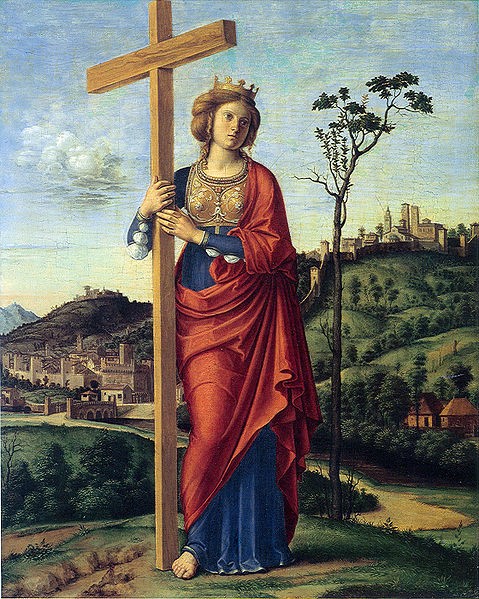This is a legend unlike any other. It all started with a young servant girl named Flavia Julia Helena.1 Born in 248 C.E. in Bithynia, a province of the Roman Empire, Helena was no different from anyone else, until the day that she caught the eye of the Roman emperor Constantius I Chlorus with her beauty.2
They married, had a son in the year 272 who, if you have ever learned anything about Roman history, you will probably know. Their son was the one and only Constantine. Constantine became one of the greatest Roman emperors. One of the things he is known for is the Edict of Milan, issued in the year 313.3 The Edict of Milan allowed for Christianity to be a freely practiced religion. It was at this time that Helena most likely converted to Christianity.4

In the year 324, Constantine sent Helena on a pilgrimage to the Holy Lands in search of the “Holy Sepulcher” and “The True Cross.” The “Holy Sepulcher” is the location of the crucifixion of Jesus Christ, while “The True Cross” is the cross on which Jesus Christ was crucified.5 On this pilgrimage, it was said that Helena “followed in the footsteps of Jesus,” by performing many acts of kindness and good works, such as giving money, food, and clothing to the poor, and also helping churches with funds as well as their other needs.6 After weeks of traveling, they finally made it to Jerusalem. With the help Judas Cyriancus, a man selected at random and forced against his will to help, Helena was able to get closer than she ever had to finding “The True Cross.”7 This is where the story diverges. Although some believe a commoner from a nearby town led Helena to “The True Cross,”others believe that it was Judas Cyriancus.
They continued their search for days, when their prayers were finally answered. Helena said it was then, “With sweet smelling dust and a flash of lighting pointed to the place where,” she instructed Judas to started digging.8 Finally, they uncovered three crosses, one thought to belong to Jesus Christ, and the others belonging to the two thieves that died alongside Him. To test and see which one of these crosses truly belonged to Jesus Christ, they searched for a leper at the outskirts of Jerusalem. Once one was found, they returned back to the site of Golgotha, the place of Jesus’ crucifixion. The leper was instructed to touch each of the crosses one by one. He touched the first one and nothing happened. He touched the second one and still nothing happened. Finally, when he touched the third and final cross, the leper was instantly healed.9 It was this cross that healed the leper, and for that reason it is known as the “The True Cross.”

The cross was then carried back to Constantinople, while part of the cross was placed in the hands of the bishop of Jerusalem.10 As the years passed, fragments of “The True Cross” were placed in the care of many Catholic churches around the world for all to admire. Although we may never know whether the cross they found and distributed was “The True Cross,” like all legends, in the end it is up to us whether to believe the account or not.
- Dictionary of World Biography, 2016 s.v. “Helena, St.” ↵
- Global Events: Milestone Events Throughout History, 2014, s.v. “Saint Helena Makes a Pilgrimage to the Holy Land,” by Jennifer Stock. ↵
- Global Events: Milestone Events Throughout History, 2014, s.v. “Saint Helena Makes a Pilgrimage to the Holy Land,” by Jennifer Stock. ↵
- Dictionary of World Biography, 2016 s.v. “Helena, St.” ↵
- New Catholic Encyclopedia, 2003 s.v. “Helena, St,” by J. H. Geiger. ↵
- Global Events: Milestone Events Throughout History, 2014, s.v. “Saint Helena Makes a Pilgrimage to the Holy Land,” by Jennifer Stock. ↵
- Barbara Baert, “New Observations on the Genesis of Girona (1050-1100). The Iconography of the Legend of the True Cross,” Gesta 38, no. 2 (1999): 117-121. ↵
- Barbara Baert, “New Observations on the Genesis of Girona (1050-1100). The Iconography of the Legend of the True Cross,” Gesta 38, no. 2 (1999): 117-121. ↵
- Barbara Baert, “New Observations on the Genesis of Girona (1050-1100). The Iconography of the Legend of the True Cross,” Gesta 38, no. 2 (1999): 117-121. ↵
- Religious Celebrations: An Encyclopedia of Holidays, Festivals, Solemn Observances, and Spiritual Commemorations, 2011, s.v. “Elevation of the True Cross (September 14),” by J. Gordon Melton. ↵



56 comments
Kristy Feather
I loved how this article discussed Helena’s religious pilgrimage, but I would personally love to more about her life. She was a slave girl before she married into power, I would like to more about her family and the life she lived as she turned from someone who served to being served. Not only that, but knowing more of her role as a queen before her pilgrimage would truly help to illuminate her sainthood.
Emily Jensen
What a great story. I really appreciated the way that the author presented the story with an unbiased viewpoint. She laid out the facts, admitted where the story facts get mixed, and tied everything together in a way that makes sense. Having never heard of the True Cross, this article did a fantastic job a capturing and keeping my attention throughout the entire story.
Roman Olivera
This a brief but informative article about a woman that I probably would have never otherwise researched. I have know the stories about her son Constantine but had never even heard anything about her influences on the early church. Flavia Julia Helena or St. Helena as she is know, went on a journey to find the Lord spiritually and ended up with what many in the early church believed to be the cross of Christ. Like the article says, whether we choose to believe that she found the true cross of Christ or not, that is our choice. As for the church and the people of that time, they believe in her as a woman of great faith that followed in the foot steps of Jesus. This a great story of a woman of great faith and an account of her contributions to the early church.
Nathalie Herrera
This was a very interesting read especially since I unfortunately had never heard of the the legend of the true cross before. It was fascinating to read how leaper was instantly healed with the touch of the true cross. Not only that, but how the legend ends, which is the mystery of the true cross after fragments were placed in Catholic churches. Great read!
Sienna Guerra
I have never heard of St. Helena and the legend of the true cross in which she discovered herself. This article explains how Helena herself “walked the footsteps of Jesus” and determined that the cross she knew was the “True One” was the cross Jesus was crucified on. I also find it amazing how the True Cross healed the leaper by the touch of it which is really powerful knowing during the Passion of the cross, when Catholics have the opportunity to touch the cross, they feel the presence of God.
Luke Lopez
This was a great article about St. Helena and her discovery of the True Cross. It is truly amazing the way that they determined which of the three crosses was the one that Jesus was crucified on. I find this article very interesting, because the Church that I go to has a relic of the True Cross, and every Good Friday service the relic of the True Cross is brought out for the congregation to see and touch.
Eric Ortega Rodriguez
Growing up Catholic, there were always questions that I asked myself when it Easter time came. I would repeatedly ask my parents what had happened to the cross Jesus was crucified on. Although, this article leaves it up to the audience to decide whether it is true or not. It is fascinating to read something that talks about a question a had for a while now. What I found most fascinating about this story was how they found which of the three crosses was ” The True Cross.” It truly demonstrates the power Jesus had even when he was not physically present.
Matthew Bustamante
Being a devout Catholic I always strive to find what the Catechism calls “motives of credibility”. Meaning that to nourish our Faith, we must be open to the historical critical method and the work of historians and others in the field of historical truth. This was a great summary of the pilgrimage to St. Helena and a great nourishment for those who would like to increase their faith.
Eloisa Sanchez Urrea
I was raised in a traditional Catholic home, but as I have gotten older I’ve realized that I do not know much of the history behind our beliefs. As I read this article I was intrigued to learn of the journey Helena traveled to find The True Cross. The last few lines of the article left me to ask myself whether this was true. If not, then where did this legend come from and what is its purpose?
Daniela Duran
This is truly a fascinating story! But, as a matter of fact, it seems more like a reality to me! It’s amazing to see how much miracles such as these have happened in our world. The idea of the Cross healing the leper was incredible! I truly enjoyed reading this article, not only because of the theme, but also because of the intriguing way in which it was told. I believe that there should be so much articles like this one nowaday…articles which actually promote the presence of miracles and of God in our way! I would really like to know if it was actually Judas Cyriancus who led Saint Helena to the True Cross! that would be something great to research. I wasn’t even aware of the fact that this cross had been found, and never had I thought that it had been placed in different parts around otherworld! That simply seems amazing. I would also enjoy knowing what Constantine said once his mother returned with the cross!